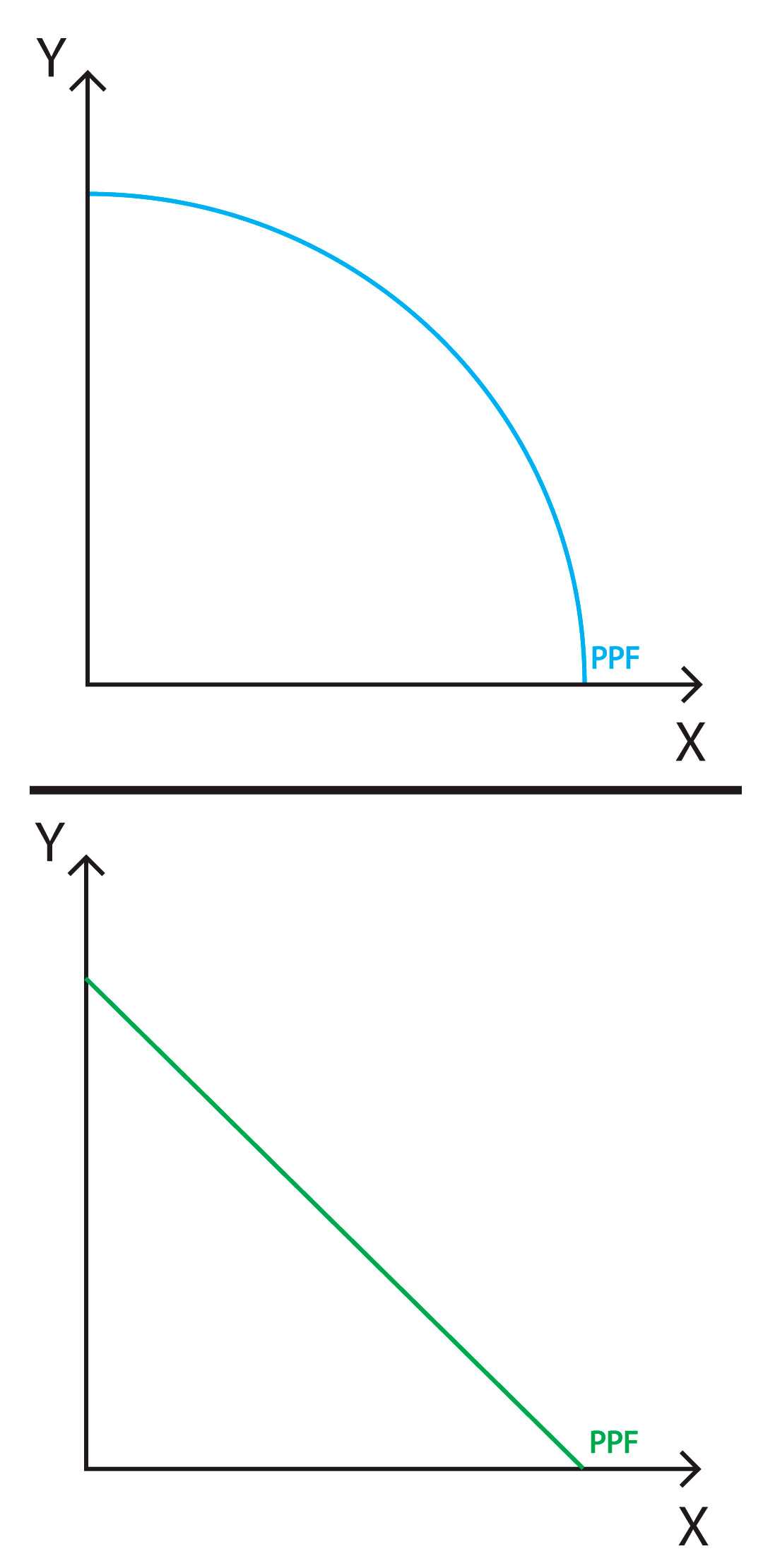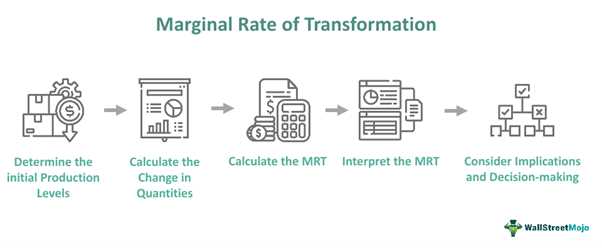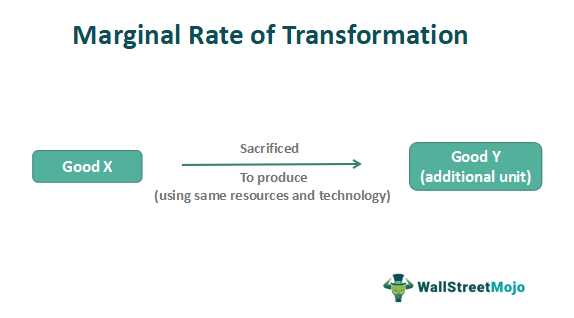Marginal Rate of Transformation (MRT) Definition
The Marginal Rate of Transformation (MRT) is a concept in microeconomics that measures the rate at which one good must be sacrificed in order to produce an additional unit of another good, while keeping the total level of production constant. It represents the trade-off between producing one good and producing another.
Importance of MRT in Microeconomics

The MRT is also used to analyze the concept of comparative advantage in international trade. It helps countries determine which goods they should specialize in producing based on their MRT values. Countries with a lower MRT for a particular good have a comparative advantage in producing that good, and can benefit from trading with countries that have a higher MRT for the same good.
Calculation of MRT
The MRT is calculated by taking the ratio of the change in the quantity of one good to the change in the quantity of another good. It can be expressed mathematically as:
MRT = ΔQ1 / ΔQ2
Where ΔQ1 represents the change in the quantity of the first good, and ΔQ2 represents the change in the quantity of the second good.
Factors Affecting MRT
Several factors can affect the MRT:
- Technological constraints: The availability of technology and production techniques can influence the MRT. Advanced technology can lead to a more efficient production process and a lower MRT.
- Resource availability: The availability and quality of resources can affect the MRT. Scarce resources or resources with limited productivity can result in a higher MRT.
- Economies of scale: The scale of production can influence the MRT. Economies of scale, where production costs decrease as output increases, can lead to a lower MRT.
- Specialization: The degree of specialization in production can impact the MRT. Specializing in a particular good can lead to a lower MRT for that good.
These factors highlight the complexity of determining the MRT and the importance of considering various economic factors in its calculation.
Interpretation of MRT
The MRT represents the opportunity cost of producing one additional unit of a good in terms of the quantity of another good that must be given up. A higher MRT indicates a higher opportunity cost, meaning more resources must be sacrificed to produce an additional unit of the desired good.
Conversely, a lower MRT indicates a lower opportunity cost, meaning fewer resources are required to produce an additional unit of the desired good. This interpretation helps economists and policymakers make informed decisions regarding resource allocation and trade.
What is MRT and why is it important in microeconomics?

The Marginal Rate of Transformation (MRT) is a concept used in microeconomics to measure the rate at which one good must be sacrificed in order to produce an additional unit of another good, while keeping the total level of production constant. It represents the trade-off between producing one good and producing another.
For example, if the MRT of producing cars for producing computers is 2, it means that in order to produce one additional computer, two cars must be sacrificed. This information can be used by policymakers and businesses to make decisions about resource allocation and production strategies.
Calculation of Marginal Rate of Transformation (MRT)
The Marginal Rate of Transformation (MRT) is a concept used in microeconomics to measure the rate at which one good must be sacrificed in order to produce an additional unit of another good. It represents the slope of the production possibilities frontier (PPF) and helps economists understand the trade-offs involved in production decisions.
To calculate the MRT, you need to know the quantities of the two goods being produced and the amount of resources available. Let’s consider a simple example:
Example:
Suppose a country can produce either cars or computers. The table below shows the different combinations of cars and computers that can be produced with the available resources:
| Combination | Cars | Computers |
|---|---|---|
| A | 10 | 0 |
| B | 8 | 2 |
| C | 6 | 4 |
| D | 4 | 6 |
| E | 2 | 8 |
| F | 0 | 10 |
To calculate the MRT between two combinations, you need to determine the change in the quantity of one good divided by the change in the quantity of the other good. Let’s calculate the MRT between combinations A and B:
MRT (A to B) = (Change in Cars) / (Change in Computers)
MRT (A to B) = -2 / 2
MRT (A to B) = -1
The negative value of -1 indicates that in order to produce 1 additional computer, 1 car must be sacrificed. This negative slope represents the trade-off between the two goods.
Similarly, you can calculate the MRT between other combinations to understand the trade-offs involved in production. The MRT can also be used to determine the efficiency of production and identify points of specialization.
How to Calculate MRT in Microeconomics?
In microeconomics, the Marginal Rate of Transformation (MRT) is a concept that measures the rate at which one good must be sacrificed to produce an additional unit of another good, while keeping the total level of production constant. It is an important tool for analyzing production possibilities and efficiency in an economy.
Step 1: Identify the Two Goods
The first step in calculating MRT is to identify the two goods that are being produced or consumed. For example, let’s say we have two goods: apples and oranges.
Step 2: Determine the Units of Production
Next, determine the units of production for each good. For example, let’s say we can produce apples in bushels and oranges in crates.
Step 3: Calculate the Change in Production
To calculate MRT, we need to determine the change in production of one good when the production of the other good is increased by one unit. For example, if we increase the production of oranges by one crate, how many bushels of apples do we need to sacrifice?
Step 4: Divide the Change in Production
Finally, divide the change in production of one good by the change in production of the other good. This will give us the MRT. For example, if we need to sacrifice 2 bushels of apples to produce 1 crate of oranges, the MRT would be 2/1 or 2.
By calculating the MRT, economists can analyze the efficiency of resource allocation and determine the trade-offs involved in producing different goods. It provides insights into the opportunity cost of producing one good over another and helps in making informed decisions regarding resource allocation and production.
Factors Affecting Marginal Rate of Transformation (MRT)
The Marginal Rate of Transformation (MRT) is an important concept in microeconomics that measures the rate at which one good must be sacrificed in order to produce an additional unit of another good, while keeping the total production level constant. The MRT is influenced by various factors that affect the efficiency and productivity of the production process.
1. Technological Advancements: Technological advancements can significantly impact the MRT. When new technologies are introduced, they often lead to increased productivity and efficiency in the production process. This can result in a lower MRT, as fewer resources are required to produce the same level of output. On the other hand, outdated or inefficient technologies can lead to a higher MRT, as more resources are needed to produce the same amount of goods.
3. Specialization and Division of Labor: The degree of specialization and division of labor within an economy can impact the MRT. When individuals or firms specialize in the production of a particular good, they can become more efficient and productive, leading to a lower MRT. Conversely, if there is a lack of specialization and division of labor, the MRT may be higher, as resources are not being utilized optimally.
5. Government Policies and Regulations: Government policies and regulations can also impact the MRT. For example, trade barriers, such as tariffs or quotas, can increase the MRT by restricting access to certain resources or markets. Similarly, regulations that impose additional costs or requirements on production can also affect the MRT.
6. Time Horizon: The time horizon considered can also influence the MRT. In the short run, the MRT may be higher as resources are less flexible and cannot be easily reallocated. However, in the long run, the MRT may decrease as firms have more time to adjust their production processes and allocate resources more efficiently.
Factors Affecting Marginal Rate of Transformation (MRT)
The Marginal Rate of Transformation (MRT) is an important concept in microeconomics that measures the rate at which one good must be sacrificed in order to produce an additional unit of another good, while keeping the total level of production constant. The MRT helps economists understand the efficiency and trade-offs involved in production decisions.
1. Technological Factors
Technological factors play a crucial role in determining the MRT. The level of technology available to a firm affects its ability to transform resources into goods. A more advanced technology can lead to a higher MRT, as it allows for greater efficiency in production and the ability to produce more output with the same amount of resources.
2. Resource Availability

The availability of resources also influences the MRT. When resources are abundant, the MRT tends to be lower because there is less need to sacrifice one good in order to produce more of another. Conversely, when resources are scarce, the MRT tends to be higher as firms must give up more of one good to produce additional units of another.
3. Specialization and Division of Labor
The degree of specialization and division of labor within an economy can affect the MRT. When workers specialize in specific tasks, they become more efficient at producing those goods, leading to a lower MRT. On the other hand, if workers are less specialized and perform a wider range of tasks, the MRT may be higher due to the increased trade-offs involved in producing different goods.
4. Time Horizon
The time horizon considered in production decisions can impact the MRT. In the short run, firms may be constrained by fixed resources and technology, leading to a higher MRT. However, in the long run, firms have more flexibility to adjust their resources and technology, potentially reducing the MRT.
5. Economic Efficiency
Economic efficiency, or the ability to maximize output with given resources, is closely related to the MRT. When firms operate at their production possibility frontier, they are considered to be economically efficient, and the MRT is optimized. Any deviation from this frontier indicates that resources are not being allocated efficiently, resulting in a suboptimal MRT.
Interpretation of Marginal Rate of Transformation (MRT)
The MRT is calculated by taking the ratio of the change in the quantity of one good to the change in the quantity of another good. It provides insights into the efficiency and opportunity costs of production. A higher MRT indicates a larger sacrifice of one good to produce more of another, while a lower MRT suggests a smaller sacrifice.
The MRT is represented graphically by the slope of the production possibilities curve (PPC). The PPC shows the maximum combination of goods that can be produced given the available resources and technology. The slope of the PPC represents the MRT and reflects the trade-offs faced by producers.
Implications of the MRT
The MRT has several important implications in microeconomics:
- Opportunity Cost: The MRT reflects the opportunity cost of producing one good in terms of the other. It helps decision-makers understand the trade-offs involved in allocating resources and making production choices.
- Efficiency: The MRT can be used to assess the efficiency of resource allocation. If the MRT is constant, it indicates that resources are being allocated efficiently. If the MRT is increasing, it suggests that resources are being underutilized.
- Economic Growth: Changes in the MRT over time can indicate shifts in the production possibilities of an economy. If the MRT decreases, it suggests that the economy is experiencing economic growth and becoming more efficient in production.

Emily Bibb simplifies finance through bestselling books and articles, bridging complex concepts for everyday understanding. Engaging audiences via social media, she shares insights for financial success. Active in seminars and philanthropy, Bibb aims to create a more financially informed society, driven by her passion for empowering others.
